#vitamin B3 foods
Link
1 apple calories, apples, vitamin, foods, Boron, fruit, negative calories, weight loss, Best 13 Tips For Health Benefits of Apples, Office Suite, iPad, iPhone, iPod Touch, B3, Iron, Calcium, Magnesium, Zinc, World Series, Vitamin C, Best 12 Tips, Healthy Low-Calorie Dessert Recipes, fat per serving, health, Apple Watch, quercetin, Orange Cheesecake, calories, fiber, LDL, weight, healthy, nutrients, minerals, potassium, energy, eat, body, eating, vegetables, diet, crops, sugar, grams, fat, juice, consume, consumed, meal
#1 apple calories#apples#vitamin#foods#Boron#fruit#negative calories#weight loss#Best 13 Tips For Health Benefits of Apples#Office Suite#iPad#iPhone#iPod Touch#B3#Iron#Calcium#Magnesium#Zinc#World Series#Vitamin C#.Best 12 tips#Healthy Low-Calorie Dessert Recipes#fat per serving#health#Apple watch#quercetin#Orange Cheesecake#calories#fiber#LDL
3 notes
·
View notes
Text
Foods You Can Eat Instead of Taking Vitamins and Supplements 🍎🥥🥦🥑🍌
Vitamin A: Carrots, sweet potatoes, spinach, kale.
B Vitamins: Whole grains, meat, eggs, nuts, legumes.
Vitamin B1 (Thiamine): Whole grains, legumes, nuts, pork, fortified cereals.
Vitamin B2 (Riboflavin): Dairy products, lean meats, almonds, leafy greens.
Vitamin B3 (Niacin): Poultry, fish, nuts, legumes, whole grains.
Vitamin B5 (Pantothenic Acid): Meat, poultry, eggs, avocado, whole grains.
B6: Chicken, turkey, fish, bananas, chickpeas.
Folate (Vitamin B9): Leafy greens, legumes, citrus fruits, fortified grains.
Vitamin B12: Animal products (meat, fish, dairy), fortified plant-based foods.
Vitamin C: Citrus fruits, strawberries, bell peppers.
Vitamin D: Fatty fish (salmon, mackerel), fortified dairy products, sunlight.
Vitamin E: Sunflower seeds, almonds, vegetable oils, nuts, spinach, broccoli.
Vitamin F (Essential Fatty Acids): Fatty fish, flaxseeds, chia seeds, walnuts.
Vitamin H (Biotin): Eggs, nuts, sweet potatoes, salmon, avocado.
Vitamin K: Leafy greens (kale, spinach), broccoli, Brussels sprouts.
Vitamin K2: Fermented foods (natto, cheese), animal products, leafy greens.
Vitamin L1 (Anthranilic Acid): Cruciferous vegetables (cabbage, cauliflower), legumes.
Vitamin P (Bioflavonoids): Citrus fruits, berries, onions, green tea.
Vitamin Q (Ubiquinone): Fatty fish, organ meats, spinach, cauliflower.
Vitamin T (L-carnitine): Red meat, poultry, fish, dairy products.
Vitamin U (S-Methylmethionine): Cabbage, broccoli, Brussels sprouts.
Betaine: Beets, spinach, whole grains, seafood.
Boron: Fruits (apples, pears), legumes, nuts, avocado.
Calcium: Dairy products, leafy greens (kale, collard greens), almonds.
Carnosine: Beef, poultry, fish.
Carnitine: Red meat, dairy products, fish.
Catechins: Green tea, black tea, dark chocolate.
Choline: Eggs, liver, beef, broccoli, soybeans.
Creatine: Red meat, fish, poultry.
Chromium: Broccoli, whole grains, nuts, brewer's yeast.
Chondroitin: Cartilage-rich foods (bone broth, connective tissue of meat).
Copper: Shellfish, nuts, seeds, organ meats, lentils.
Coenzyme Q10 (CoQ10): Fatty fish, organ meats, nuts, soybean oil.
Ellagic Acid: Berries (strawberries, raspberries), pomegranates.
Glucosinolates: Cruciferous vegetables (cabbage, broccoli, cauliflower).
Glucosamine: Shellfish (shrimp, crab), bone broth, animal connective tissues.
Glutamine: Dairy products, meat, poultry, cabbage.
Inositol: Citrus fruits, beans, nuts, whole grains.
Iodine: Seafood, iodized salt, dairy products.
Iron: Red meat, poultry, beans, lentils, spinach.
L-Theanine: Mushrooms, black tea, white tea, guayusa.
Lignans: Flaxseeds, whole grains, cruciferous vegetables.
Lutein and Zeaxanthin: Leafy greens (spinach, kale), corn, eggs.
Lycopene: Tomatoes, watermelon, pink grapefruit.
Magnesium: Spinach, nuts, seeds, whole grains, beans.
Manganese: Nuts, seeds, whole grains, leafy greens, tea.
Melatonin: Cherries, grapes, tomatoes.
Omega-3 fatty acids: Flaxseeds, chia seeds, walnuts, fatty fish.
PABA (Para-Aminobenzoic Acid): Whole grains, eggs, organ meats.
Pantothenic Acid (Vitamin B5): Meat, poultry, fish, whole grains, avocado
Pectin: Apples, citrus fruits, berries, pears.
Phosphorus: Dairy products, meat, poultry, fish, nuts.
Prebiotics: Garlic, onions, leeks, asparagus, bananas (unripe), oats, apples, barley, flaxseeds, seaweed.
Probiotics: Yogurt, kefir, fermented foods (sauerkraut, kimchi).
Potassium: Bananas, oranges, potatoes, spinach, yogurt.
Polyphenols: Berries, dark chocolate, red wine, tea.
Quercetin: Apples, onions, berries, citrus fruits.
Resveratrol: Red grapes, red wine, berries, peanuts.
Rutin: Buckwheat, citrus fruits, figs, apples.
Selenium: Brazil nuts, seafood, poultry, eggs.
Silica: Whole grains, oats, brown rice, leafy greens.
Sulforaphane: Cruciferous vegetables (broccoli, Brussels sprouts), cabbage.
Taurine: Meat, seafood, dairy products.
Theanine: Green tea, black tea, certain mushrooms.
Tyrosine: Meat, fish, dairy products, nuts, seeds.
Vanadium: Mushrooms, shellfish, dill, parsley, black pepper.
Zeatin: Whole grains, legumes, nuts, seeds.
Zinc: Oysters, beef, poultry, beans, nuts, whole grains.
#women health#health and wellness#healthy diet#healthy living#healthy lifestyle#womens health#health#health tips#wellness#levelupjourney#dream girl guide#dream girl tips#dream girl journey#health is wealth#clean girl aesthetic#clean girl#it girl#nutrition#supplements#organic#food#nutrients#healthyhabits#healthy life tips#self love journey#self love#dream life#dream girl
2K notes
·
View notes
Text
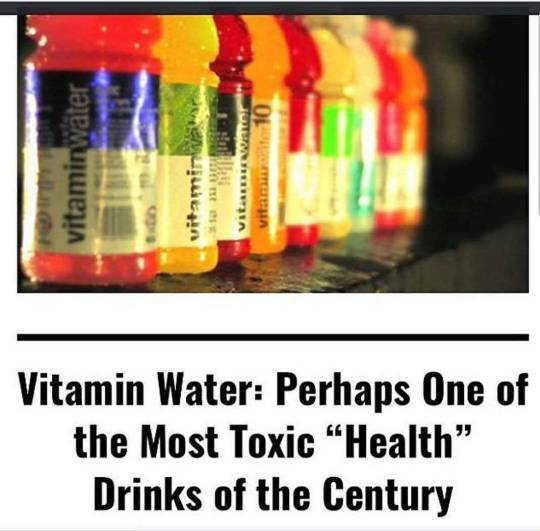
Coca-Cola’s VitaminWater is being marketed as a healthy, hydrating drink. The company claims that the drinks prevent chronic diseases, reduce the risks of eye diseases, promotes healthy joints, and supports optimal immune function. However, nothing could be further from the truth.
This is what John Robbins, Esq., PhD., M.D. says in his Mat Hoffman Post article:
The product is basically sugar-water, to which about a penny’s worth of synthetic vitamins have been added. And the amount of sugar is not trivial. A bottle of vitaminwater contains 33 grams of sugar, making it more akin to a soft drink than to a healthy beverage.
The ingredients of “orange-orange”-flavored vitaminwater:
Reverse osmosis water, crystalline fructose, cane sugar, less than 0.5% of: citric acid, magnesiumlactate and calcium lactate and potassium phosphate (electrolyte sources), natural flavors, vitamin C (ascorbic acid), gum acacia, vitamin B3 (niacinamide), vitamin E (alpha-tocopheryl acetate), vitamin B5 (calcium pantothenate), glycerol ester of rosin, vitamin B6 (pyridoxine hydrochloride), vitamin B12, beta-carotene, modified food starch, sorbitol.
VitaminWater’s sugar levels are very very high. One 500ml bottle contains 27 grams of sugar, that’s about 8 teaspoons of sugar!
Crystalline Fructose
Crystalline fructose is produced by allowing the fructose to crystallize from a fructose-enriched corn syrup. So basically, it is made from corn syrup, and not only corn syrup, but “fructose enriched” corn syrup. Crystalline Fructose contains 99.5% minimum of fructose assay, which is a greater higher percentage of fructose than what makes up high fructose corn syrup. Crystalline fructose may be contaminated with arsenic, lead, chloride and heavy metals. This type of fructose leads to increased belly fat, insulin resistance, and metabolic syndrome. Large amount of fructose can create a fatty liver and cirrhosis as it can not be processed completely in the liver. The fructose interferes and alters the metabolic process in our cells, which causes oxidative damage.
14 notes
·
View notes
Text
。☆✼★my food rules ★✼☆。
cant have processed sugar
I'm only allowed 2 meals a day
I'm allowed one small snack
my highest cal intake can't be over 800cals
i must drink at least 2,5L of water daily
i have to do minimum 10k steps a day
i must streach in the morning and before bed
i cant have normal soda, only diet/0cal
no candy/fastfood
I'm not allowed to take food from people even if they insist
if i go to the store I'm only allowed to buy gum, water or 0cal soda/energy drinks
if i feel very weak i can allow myself one juicebox
i can only weigh myself once a week/once every two weeks (makes me stay on track bc i keep worrying about messing up by eating)
for every kilogram i lose i buy myself one treat (it can't be food, more like some makeup or a plush)
if i do get over my cal limit for the day i must exercise it off, i can't purge it or use laxatives as that would be to easy
every week i just fast at least for one day
on the weekends ill alow myself to eat up to 900 cals
i must take my vitamins daily (zink, vitamin B3, D, C, iron)
make sure people always see me eating so they don't get suspicious
always lie and say u had breakfast, ate at a friend's house
and remember, maintaining is better than gaining !!!
#anor3x14#b0ne#b0nesp0#b0nespo#b0nespø#eat1ng dis0rder#notprojustusingthetags#pro @na#th1n$po#th1nsp1r4t10n
180 notes
·
View notes
Text
What can be eaten for a healthy breakfast in the morning?



Oatmeal
Benefits: Regulates digestion and helps keep you full longer.
Vitamins: B vitamins (B1, B5, B6), iron, magnesium, zinc.
Greek Yogurt
Benefits: Provides high protein for satiety; contains probiotics for digestive health.
Vitamins: Calcium, B vitamins (B2, B12), vitamin D (in some varieties).
Whole Grain Bread
Benefits: Rich in fiber, supports digestive health, and helps stabilize blood sugar levels.
Vitamins: B vitamins (B1, B3, B5), iron, magnesium.
Fruits
Benefits: Rich in vitamins, minerals, and antioxidants; supports immune health.
Vitamins: Vitamin C (especially citrus fruits and strawberries), potassium, vitamin A (in some fruits).
Eggs
Benefits: Provides high-quality protein and healthy fats; supports brain function.
Vitamins: Vitamin A, vitamin D, vitamin B12, choline.
Avocado
Benefits: Contains healthy fats and fiber; supports heart health and improves digestion.
Vitamins: Vitamin E, vitamin K, vitamin C, B vitamins (B5, B6).
Nuts and Seeds
Benefits: Provides healthy fats, protein, and fiber; supports heart health.
Vitamins: Vitamin E, magnesium, B vitamins (especially B6).
Smoothie
Benefits: High in vitamins and minerals, especially when enriched with green leafy vegetables.
Vitamins: Vitamin C (from fruits), vitamin A and K (from green leafy vegetables).
Quinoa
Benefits: High in protein and fiber; helps with satiety and energy.
Vitamins: B vitamins (B1, B2, B6), iron, magnesium, phosphorus.
Chia Pudding
Benefits: Provides omega-3 fatty acids, fiber, and protein; supports digestion.
Vitamins: Vitamin E, B vitamins (B1, B3), calcium.
Vegetable Omelet
Benefits: Rich in protein and vitamins; provides satiety.
Vitamins: Vitamin A (from vegetables), vitamin C (from vegetables), B vitamins (from eggs).
Cottage Cheese
Benefits: High in protein and calcium; supports bone health.
Vitamins: Calcium, B vitamins (B2, B12).
Whole Grain Crackers
Benefits: Provides fiber and complex carbohydrates; supports digestion.
Vitamins: B vitamins (B1, B3), iron.
Milk and Plant-Based Milks
Benefits: Provides calcium and vitamin D; supports bone health.
Vitamins: Calcium, vitamin D (in milk and some plant-based milks).
These options ensure a balanced and nutritious breakfast!!
(If you are sensitive or allergic to any of the foods here, please do not consume)
(Photos are not mine)
#healthylifestyle#healthy diet#healthy food#healthy breakfast#health#health tips#healthy eating#food#breakfast
4 notes
·
View notes
Text
TIPS AND TRICKS !!
drink warm skim or almond milk (skim milk is higher in calories, but keeps you full for longer and increases your metabolism)
omad dinner (i’ll make a post how to make it easy, simple and keep you full all day long)
drink so so much green or white tea!! (both burn calories, increase your metabolism and make you feel full)
so So SO much water!!! cant stress this enough. water is so important when losing weight. (i’ll make a post about ways to drink water, and how to always remember about drinking it)
personally, getting rid of tiktok was such a significant move for me. tiktok made me stay up late which slows down your metabolism and it also made me bored often, which lead to cravings. now that i’m without it, i have time to study, read and be productive, which keeps me distracted and i don’t think about food.
avoid carbs like bread, pasta, potatoes and instead choose rice, vegetables and oatmeal!
take! your! vitamins! (B2, B3, B4, B6, D)
#i need to lose so much weight#lekka jak motyl#th1n$po#ana trigger#f@sting#b1nge eating#disordered eating thoughts#it's not as simple as just eating#weight loss
73 notes
·
View notes
Text
Thing's Rambles #1: Eggs
Eggs! You know them, you love them—at least I hope so, considering how awesome... Food?... They are. I think eggs are a category of their own. Ah, whatever, we're going out of topic.
(long shtick about eggs below, will bore u to death)
One of the reasons eggs, chicken eggs specifically, are so crucial to the past and modern day is because the birds who lay them can do so indefinitely as opposed to other birds who only lay a certain number at a time. So long as their nest is empty, presumably taken by predators (humans), then they can lay just about every day. In the industry, male chicks are basically useless, which results in a mass crush every day. Fortunately, scientists are working on changing the sex of the chick in the eggs. However, I don't know anything about that yet.
Speaking of eggs, a man somewhere in the 1970's conducted the '7 Country Study', his conclusion being that eggs raise the chances of CVD (cardiovascular disease, AKA heart attacks) by 17% due to the SatFat (saturated fat) and cholesterol. This, of course, raised panic and attention in the public, especially when the government set guidelines for saturated fat and cholesterol. While this link isn't necessarily 100% false, it is a clunking argument. Especially in comparison to the other study linking IR (insulin resistance) to CVD, which is also linked to high sugar and high carbohydrate consumption. And while it's still not an all-time cause, it's still true 90% of the time. Remember the '7 Country Study' I mentioned prior? It was actually conducted in 22 countries, except 15 of them proved to be against what the study was about, so he ditched them. What's even more baffling than this is that even after 50 years of study after study after study, these government guidelines are still in place. Eggs do not cause CVD, rather the exact opposite, and then some more.
I'm not completely sure what the nutrients that specifically fight against CVD are (mainly because they have unpronounceable names), but eggs still carry massive benefits for your skin, muscles, bones, organs, and even your brain! This is because of the many vitamins (especially vitamin B) and high protein. Time for the main part.
Laying it all out front, a whole egg contains: Vit A (has a part in yolk coloring), Vit E (good for the heart and skin), Vit K1, Vit B1, B2, B3, B5, B6, B12, and Vit D. Those are just the vitamins. Eggs also contain DHA (omega 3), which is for the brain; folate for degenerative disease; choline to burn fat and help against fatty liver; and lutein and zeaxanthin, which are beneficial for your eyes.
And then protein—my favorite part. It's amazing, really, because of its ability to help build protein tissues and the percentage of egg protein made into our protein. In comparison, we get 17% of its protein from soy, 16% from whey, 32% from meat or fish, and a whopping 48% from eggs. You can really see the difference between egg yolk and egg white when you take into consideration that egg white's percentage is merely 17%.
Alright, so now that we know we get a lot of protein from eggs, what do we do with that protein?
Well, how it works is that when our body receives protein, it either invests it into tissues (skin, muscles, bones) or energy (glucose). The ratio of how much protein is invested in tissues to glucose is actually dependent on the meal from which the protein is extracted. For example, when you get protein from meat, 30% of that protein goes into the development of your skin, muscles, bones, joints, etc. (tissues), and 70% of the protein becomes glucose (energy). For eggs, it's 49% for tissues and 51% for glucose, ranking it as the highest rate of protein for tissues, but only after breastmilk, which is a whole different and fascinating discussion.
So far, we've talked about why chicken eggs are special, scandals against them, and the great yet still incomplete benefits of them. Lastly, we will talk about egg quality.
-Is the price difference between cheap and expensive eggs worth it?
Absolutely! You'll be getting more bang for your buck. In fact, some suggest that buying the cheap ones makes you gain 40–60% less worth.
-Types of eggs: Pasture eggs are definitely the best type. The others are free-range eggs and no-cage eggs, etc.; eh, most of these are just marketing terms anyway.
-Yolk color; do they matter? Well, yes, but actually, no. They do, sure, but you can't really be too sure since farmers are prone to using artificial coloring.
-Grades: grade B eggs, grade A eggs, and grade AA eggs. Do these actually matter?
No. Grades are mostly based on cosmetics, which can hardly matter much when you whisk them up for baking. Plus, your grocery eggs are probably already grade A eggs.
All in all, the quality of eggs depends on what the chickens are fed and if they're ethically raised, but you can't control those factors. But what can you control? The way the eggs themselves are prepared.
Dr. Berg suggests the best method is cracking the egg on a lit pan, waiting until the whites turn into their white color but not too much, and then scrambling them. This way, you can optimize how much nutrition and protein you can squeeze out of your egg. Too tedious? Just scramble them normally.
I think the best part of eggs, despite how beneficial they are, is how relatively cheap and accessible they are. Don'tcha think?
P.S. Remember that omega 3 I told you about? The one that's good for your brain? That's a good omega. What's not a good omega is omega 6, specifically the oil restaurants use to fry eggs and such. This one actually increases the risk of CVD.
Time for fun facts!
Fun fact: The egg white has no fat.
Fun fact: You can get 101% of the choline that your body needs in a day with just 4 eggs.
Fun fact: 90% (approximate guess) of the good stuff is in the yolks, so yeah, you're going to have to eat them.
Fun fact: This text is over a thousand words long! Congrats on reading that much!
2 notes
·
View notes
Text
What Is Hemp?
It’s A Trillion Dollar Cash Crop.
youtube
Hemp is a name given to a strain of the cannabis plant.
Hemp is a name given to cultivars of the cannabis plant (Cannabis sativa) that have been selected over many generations for fiber and seed production. Most hemp cultivars contain less than 1.5% THC, a narcotic compound that has the potential for abuse in high concentrations. Cannabis sativa cultivars selected and developed for their drug properties, referred to as marijuana, or dagga, can have a THC content of 3%-25%. Hemp is a bast fiber, producing its fibers in the stalk similar to flax, kenaf, and sun hemp.
Multiple Uses
Hemp fiber and seed are used to produce a wide range of commodities including food and beverage products, fiberboard, insulation, paper, composites, textiles, carpets, animal bedding and feed, cosmetics, body-care products, soaps, paints, fuels, and medicines.
Hemp Seed Food and Beverage Products
Hemp seed contains about 25% protein, 30% carbohydrates, & 15% insoluble fiber. Hemp seed is reported to contain more easily digestible protein than soybeans. Hemp seed contains all 8 amino acids essential to human nutrition. Hemp seed is high in calcium, magnesium, phosphorus, potassium, carotene, sulfur, iron and zinc, as well as Vitamins A, E, C, B1, B2, B3, and B6.
Hemp seed imported into the United States or Canada must be steam sterilized at between 180 degrees F and 212 degrees F for 15 minutes to prevent sprouting. Many US facilities receive imported viable seed under customs bond, steam it, and release it to the consignee or customer with a Certificate of Sterilization.
Hemp food and beverage products include hemp oil and seed, flour, pasta, cheese, tofu, salad dressings, snacks, sweets, hemp protein powders, soft drinks, beer, and wine. Hemp beer can be made from the seed, flowers, sprouts, and seed cake that is a by-product of oil pressing. Hemp beer is produced and sold in Europe and the United States of America.
Hemp Oil
Hemp seed is 25% to 35% oil, and is one of the oils lowest in saturated fats (8%). Hemp seed oil is the richest source of polyunsaturated essential fatty acids (80%). Hemp seed oil is the only common edible seed oil containing Omega-6 Gamma-Linolenic Acid. Hemp seed oil is very fragile and not suitable for cooking.
Pressed hemp seed oil must be bottled immediately under oxygen-free conditions, and must be refrigerated in dark, airtight containers.
Fiberboard
Hemp fiberboard tested by Washington State University Wood Materials and Engineering Laboratory proved to be two and one half times stronger than wood MDF composites, and the hemp composite boards were three times more elastic.
Hemp herds can be used in existing mills without major changes in equipment. Russia, Poland and other Eastern European countries already manufacture composite boards from hemp and other plant materials.
Pulp and Paper
The major use of hemp fiber in Europe is in the production of specialty papers such as cigarette paper, archival paper, tea bags, and currency paper. The average bast fiber pulp and paper mill produces 5,000 tons of paper per year. Most mills process long bast fiber strands, which arrive as bales of cleaned ribbon from per-processing plants located near the cultivation areas.
Composites
Until the 1930’s, hemp-based cellophane, celluloid and other products were common, and Henry Ford used hemp to make car doors and fenders. Today hemp herds can be used to make new plastic and injection-molded products or blended into recycled plastic products. Hemp fibers are introduced into plastics to make them stiffer, stronger and more impact resistant. Hemp plastics can be designed that are hard, dense, and heat resistant, and which can be drilled, ground, milled, and planed.
Hemp plastic products currently made include chairs, boxes, percussion instruments, lampshades, bowls, cups, spectacles, jewelry, skateboards, and snowboards.
Hemp Animal Care
Hemp horse bedding and cat litter are produced and sold in Europe. After oil is extracted from the hemp seed, the remaining seed cake is about 25% protein and makes an excellent feed for chicken, cattle, and fish. Chickens fed hemp seed on a regular basis have been found to produce more eggs, without the added hormones used in most poultry plants.
Fuels
Hemp seed oil can be combined with 15% methanol to create a substitute for diesel fuel which burns 70% cleaner than petroleum diesel. Hemp stalks are rich in fiber and cellulose, making them conducive for conversion into ethanol and methanol fuels that have a higher octane than gasoline and produce less carbon monoxide. These biomass fuels are also free from sulfur, and do not require the addition of lead and benzene used to boost octane and improve engine performance in fossil fuels. Ethanol holds condensation, eliminating oxidation and corrosion, and is reported to reduce carbon dioxide emissions by more than 30%.
Hemp has been studied in Ireland as a biomass fuel to generate electricity. Hemp has been reported to yield 1000 gallons of methanol per acre year. Hemp stalk can be converted to a charcoal-like fuel through a thermochemical process called pyrolysis. Henry Ford operated a biomass pyrolitic plant at Iron Mountain, Michigan in the mid-20th.
Paints and Varnishes and Binders
Until the 1930's, most paints were made from hemp seed oil and flax seed oil. Hemp oil makes a durable, long lasting paint that renders wood water-resistant. Hemp herds have the potential to make glues for composite construction products that are non-toxic and superior to binders currently used. With this technology, industry can produce composite products where all components are derived from hemp.
Markets for Hemp Pulp
Some paper manufacturers already have the equipment to process decorticated hemp fiber into paper. The leading European supplier of non-wood pulp, Celesa, currently produces about 10,000 tons per year of pulp from hemp. The use of hemp pulp in blends with recycled fiber of other non-wood fibers is growing. Tests by several European pulp and paper producers suggest that hemp pulp may replace cotton cost effectively in several specialty paper applications.
Potential Markets for Medical Application of Low-THC Hemp Cultivars
Many cannabis medicines have been produced using cannabis cultivars high in THC, and there has been medical research into cannabis that is low in THC and high in CBD. CBD is a cannabinoid that does not have many of the psychoactive effects associated with THC. CBD has been used to treat the following medical conditions: epilepsy, dystonic movement disorders, inflammatory disorders, pain, chronic insomnia, chorea, cerebral palsy, and Tourette's syndrome. According to a July 1998 report by the National Institute of Health, CBD may hold promise for preventing brain damage in strokes, Alzheimer’s disease, Parkinson’s disease and even heart attacks and has been found to prevent brain cell death in an experimental stroke model.
Please share this with your friends.
youtube
#hemp farming#hemp foods#hemp fuel#industrial hemp#hemp plastic#hemp paper#hemp fibers#hemp seeds#hemp prohibition
4 notes
·
View notes
Text


Hi, before I explain my post, I want to say something important.
• What you see my blog has become a major overhaul. And despite the changes, I decided that my 2nd account will be now my artwork blog with a secret twist.
⚠️NEW RULE! (W/ BIGGER TEXT!)⚠️
⚠️ SO PLEASE DO NOT SHARE MY 2nd ACCOUNT TO EVERYONE! THIS SECRECY BLOG OF MINE IS FOR CLOSES FRIENDS ONLY!⚠️
• AND FOR MY CLOSES FRIENDS, DON’T REBLOG IT. INSTEAD, JUST COPY MY LINK AND PASTE IT ON YOUR TUMBLR POST! JUST BE SURE THE IMAGE WILL BE REMOVED AND THE ONLY LEFT WAS THE TEXT.
⚠️ SHARING LINKS, LIKE POSTS, REBLOG POSTS, STEALING MY SNAPSHOT PHOTOS/RECORDED VIDEOS/ARTWORKS (a.k.a. ART THIEVES) OR PLAGIARIZING FROM UNKNOWN TUMBLR STRANGERS WILL IMMEDIATELY BE BLOCKED, RIGHT AWAY!⚠️
😡 WHATEVER YOU DO, DO NOT EVER LIKED & REBLOG MY SECRET POST! THIS IS FOR MY SECRET FRIENDS ONLY, NOT YOU! 😡

Okay? Capiche? Make sense? Good, now back to the post…↓
Take a Taste: with Uncle John's Chili Con Empanada and Sprite Lemon Plus [Recorded: Mar 30th, 2024]
Hello! It’s time for another “Take a Taste”! The series is about delicious food with my two paper dolls.
Today, it's time to share my food thoughts from the past month of March 30th, 2024; "Black Saturday" on Holy Week 🙏✝️. Once again, I break the "Holy Week" ❌🥩 rules because I ate the Chili Con Empanada from Uncle John's (formerly named: "Ministop Philippines") 🌶️🥟, with a refreshing drink of Sprite Lemon Plus in a can 🍋🥫. So, how's it taste of the Empanada from Uncle John's? 🤔 Let's find out, right now.
If you haven’t seen my previous episode, then please click → [CLICK ME!].
IMPORTANT NOTE: No #OnThisDay throwback post for this date.
So, without further ado, let’s get started:
1st & 2nd Image(s) 📷📲: ↑
• It's morning, 7:50 AM 🕖. And I'm somewhere at random Uncle John's convenience store 🇵🇭🟦🟨🏪 branch with my parents and my related family members for paying a visit at our ancestral house. But before we depart, I haven't... or WE haven't eaten breakfast by the time we arrive. So, I decided to purchase a nice hot Chili Con Empanada 🌶️🥟 worth ₱35, and a nice refreshing Sprite Lemon Plus 🍋🥫. in a can worth ₱45 (₱33 in the original suggested retail price)? I'm not sure but, I haven't tried it yet, aside from the only default Sprite flavor. 🤔
Did you know #1: I remember drinking the limited edition of "Sprite Lebron's Mix"? Yup, a collaborate with NBA superstar, LeBron James and Sprite. Which, by the way, I don't know much about NBA nor watching NBA matches because I'm not a basketball fan. ❌🏀🤷♀️ Nevertheless, as far as I know, this one tastes like authentic cherry flavor fused with Sprite's flavor, and I was surprised that this flavor Sprite drink was so good, I wish it'll be returned, soon as a normal production rather than limited. Man, I missed it, so much. 🍋🍒🥫😃😋
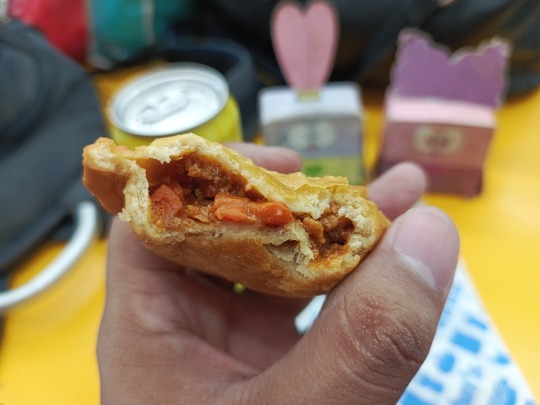
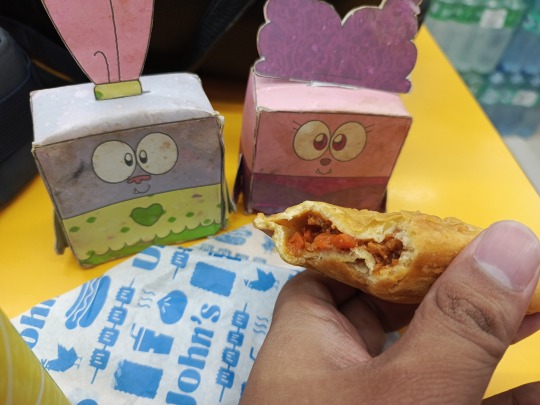


3rd to 6th Image(s) 📷📲: ↑
• Nonetheless, here's my first bite of the Chili Con Empanada. It is spicy yet very juicy with all the meaty goodness inside. 😃😋 But, is it hot though? 🤔 Nah, not at all. I can't help myself eating it, and I should order two Empanadas (of the same flavor). Here you two, want some? It is delicious! 😋

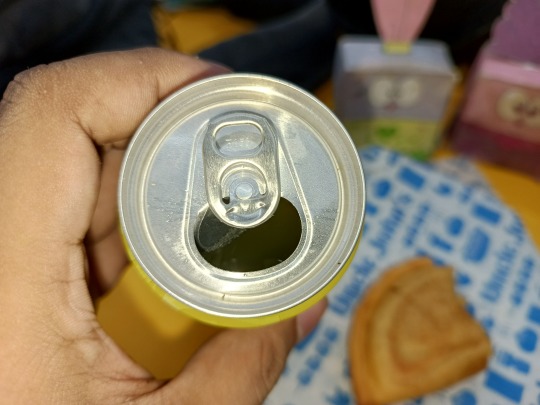

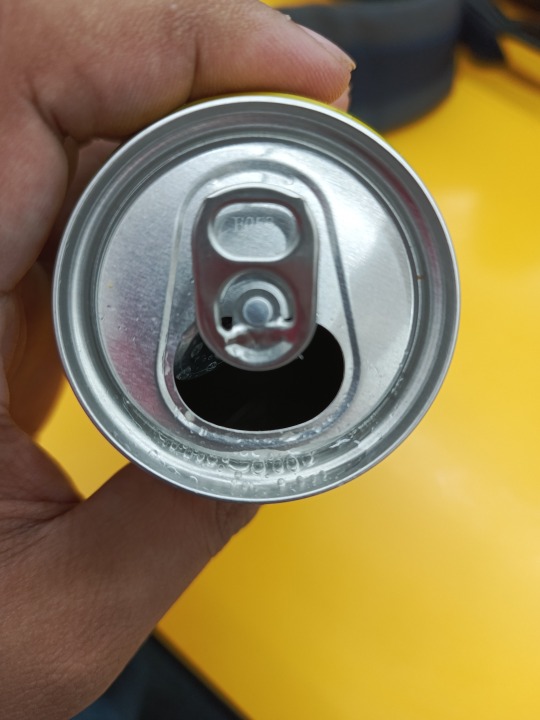
7th to 10th Image(s) 📷📲: ↑
• Now, what about the Sprite Lemon Plus? 🍋🥫🤔 For my taste, it's the same taste as the OG Sprite, unlike the "Lebron's Mix" cherry flavor. And if you want a take a peek at the color of the "Sprite Lemon Plus", I'd say it slightly yellowish blur color instead of the clear carbonate that we all know. To be honest, the appearance of the Lemon Plus is something that came out of dishwater with a dash of lemonade fruit that was squeezed in. I don't know, who knows? 🤷♀️ If only I had bought a glass to see the color, or maybe a plastic cup in my bag, or maybe I should it bought the plastic bottle format. 🤷♀️ Anyways, it says here that the "Sprite Lemon Plus" had a zesty lemon flavor, sharp fizz, caffeine, and vitamin B3. Yes, this Lemon Plus has indeed put "Caffeine" on a yellowish color carbonated drink. It's a Sprite with a little dash of Energy Drink, basically (I guess). 🍋⚡🥫 Looks like, I want a go another round of Sprite Lemon Plus, and see if I compare to the OG Sprite and the well-known Coca-Cola for the caffeine taste. Maybe, someday. 🤔
Did you know #2: That "Uncle John's" 🇵🇭🟦🟨🏪 convenience store used to be "MiniStop Philippines"? The latter was launched in 2000, until September 2022 owing to the death of former RRHI (that's "Robinsons Retail Holdings, Inc.", by the way) founder John Gokongwei, Jr. ✝️🧑💼, as well as the ending partnership of "Ministop Co." and "Mitsubishi Corporation" of Japan 🇯🇵🏢. Thus, the entire branches of "MiniStop" Philippines are now renamed to "Uncle John's" already effected by July 1st, 2023. Meanwhile, the OG "Ministop" still operates today in selected Asian regions outside Japan like Kazakhstan 🇰🇿, South Korea 🇰🇷, Viet Nam 🇻🇳 (our neighbor Southeast Asia country), and China 🇨🇳.
Overall:
• It's a solid breakfast meal! I dig the Chili Con Empanada over the greasy chicken sandwich that I've tasted before, in my previous topic. 🌶️🥟😋👍 And regardless of my thoughts of Sprite Lemon Plus, it is pretty damn refreshing. 🍋⚡🥫😋👍 And as I said, I will do a comparison between the OG Sprite for the color, and the OG Coca-Cola as well for the caffeine effect, in my next topic. Yup, this is going to be a "Sugar Rush" of soda test, I suppose. 🥤
BTW: This WASN'T the only meal I munch on because I have another meal on the same date as before. So, stay tuned for that. 😉
Well, that's all for now. 😊
If you haven’t seen my previous episodes, then I’ll provide some links down below.↓😉
Take a Taste:
○ 2021 Food Reviews: ○
• Popeyes U.S. Spicy Chicken Sandwich [Dec 6, 2021]
• Jollibee Chick'nwich & Crisscut Fries [Dec 21, 2021]: Part 1 [CLICK ME! #1], Part 2 [CLICK ME! #2]
○ 2022 Food Reviews: ○
• Mini Stop Chicken Fillet XL Sandwich [Feb 7, 2022]
• Minute Burger Cheese Burger(s) [Mar 1, 2022]
• Pepper Lunch Teriyaki Beef Pepper Rice w/ Egg (& Honey Brown Sauce) [Mar 5, 2022]
• Bacsilog’s Sulit Combo Bacon-Tocino & Samgyup Day’s Pork Herbs [Mar 12, 2022]
• Burger King Whopper w/ Sides & Drink [May 6, 2022]
• Marshmello’s Limited Edition Coca-Cola Zero [Aug 26, 2022]
• Cheesy Burger McDo with Lettuce & Tomatoes Meal [Recorded: Sept 16, 2022]
• Mcdonald’s PH McSpicy & Apple Pie (featuring their World Famous Fries) [Nov 14, 2022]
• Mcdonald’s McCrispy Hamonado Sandwich [Dec 31st, 2022]
○ 2023 Food Reviews: ○
• Foods from Delicious Restaurant & 1919 Grand Cafe [Jan 8th, 2023]
• Homemade Churros by my lil’ bro [Feb 12th, 2023]
• Lugaw Sisig from Mang Boy Alfredo Lugawan Restaurant [Recorded: Feb 18th, 2023]
• La Prato Stakehouse [Recorded: Apr 10th, 2023]
• Salt ‘n Light Snack Shack’s Cheesy Bacon Burger & Fries [Recorded: Apr 14th, 2023] (Published on May 5th, 2023)
• Delicious burger meal at Tokyo Tokyo Restaurant [Recorded: May 6th, 2023]
• Delicious meals at the Valenzuela Food Fiesta Christmas Bazaar 2023 [Recorded: Dec. 10th, 2023]
○ 2024 Food Reviews: ○
• Mang Inasal Pork Sisig [Recorded: Jan 10th, 2024]
• Mr. Shaw Shawarma Rice [Recorded: Mar 24th, 2024]
• Mang Inasal's Chicken Inasal - Pecho (Chicken Breast) [Recorded: Mar 26th, 2024]
• Samgyupsal dinner night at the Samgyup Mukbang restaurant [Recorded: May 12th, 2024]
2 notes
·
View notes
Text
This is fucking hilarious, since we used to actually take excessive amounts of Niacin to cause a "NIacin Flush" back in the '80s New Age madness!
It was a "Health/Natural food" culture staple! It was supposed to help flush "toxins" out of your blood, not lyin'...we used to take like three huge capsules at a time...literally thousands of units.
4 notes
·
View notes
Note
Hey, quick question; why does my Meowscarada eat things that are not food? He gets enough nutrition and supplements to help with things he cant get (like vitamin B3 and some grass-type nutrients to keep him healthy) but he still eats things he shouldn't
A lot of the times, catmon will just eat things out of curiosity. But, it could also be a sign of anxiety, stress, boredom, or loneliness. It it seems more like the second option, you should take him to the vet.
#quill pokecare#quill awnsers#meowscarada#rotomblr#pokemon irl#pokeblogging#pokeblog#irl pokemon#pokemon#pokeblr#rotumblr#pkmn irl#pokemon roleplay
13 notes
·
View notes
Text
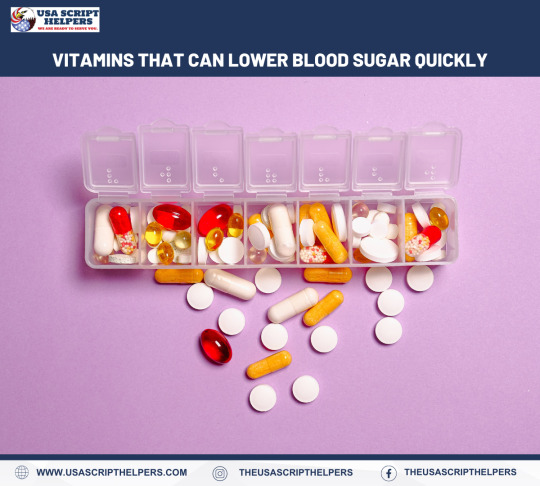
VITAMINS THAT CAN LOWER BLOOD SUGAR QUICKLY
Balancing blood sugar levels is crucial for maintaining overall health, especially for individuals with diabetes or those at risk of developing the condition. While diet, exercise, and medication play primary roles in managing blood sugar, certain vitamins and supplements can also significantly impact glucose control. This article explores vitamins known for their potential to lower blood sugar levels quickly and efficiently.
Vitamin D
Vitamin D plays a pivotal role in blood sugar regulation by enhancing the body's sensitivity to insulin, the hormone responsible for managing blood glucose levels. Insulin resistance is a common issue in individuals with type 2 diabetes, where the body fails to use insulin effectively, leading to elevated blood sugar levels. Studies suggest that maintaining adequate levels of vitamin D can improve insulin sensitivity and lower blood sugar, thus aiding in diabetes management.
Sources of Vitamin D:
Sunlight exposure
Fatty fish (salmon, mackerel, and sardines)
Fortified foods (milk, orange juice, and cereals)
Vitamin D supplements
Vitamin B1 (Thiamine)
Thiamine is essential for glucose metabolism, helping convert carbohydrates into energy. People with diabetes often have low levels of thiamine, which can contribute to higher blood sugar levels and complications. Thiamine supplements, particularly in the form of benfotiamine (a lipid-soluble derivative of thiamine), have been shown to improve glucose metabolism and reduce the risk of developing diabetes-related complications.
Sources of Vitamin B1:
Whole grains
Pork
Nuts and seeds
Legumes
Thiamine supplements, including benfotiamine
Vitamin B3 (Niacin)
Niacin, or vitamin B3, influences blood sugar control indirectly through its role in converting food into energy. However, high doses of niacin can increase blood sugar levels, making it necessary for individuals with diabetes or those at risk to consult a healthcare provider before taking niacin supplements.
Sources of Vitamin B3:
Turkey
Chicken breast
Peanuts
Mushrooms
Supplements, with medical guidance
Vitamin C
Vitamin C, an antioxidant, can lower blood sugar levels and help manage diabetes by improving glucose metabolism and protecting cells from damage caused by excess sugar in the blood. Research indicates that vitamin C supplementation can help reduce fasting blood sugar levels and improve blood sugar control in people with type 2 diabetes.
Sources of Vitamin C:
Citrus fruits (oranges, lemons, and grapefruits)
Kiwi
Strawberries
Bell peppers
Supplements
Magnesium
Though not a vitamin, magnesium is a crucial mineral that aids in blood sugar control. It plays a significant role in glucose metabolism and insulin action. Low levels of magnesium are linked to insulin resistance, a condition often preceding type 2 diabetes. Increasing magnesium intake through diet or supplements can improve insulin sensitivity and lower blood sugar levels.
Sources of Magnesium:
Spinach
Pumpkin seeds
Almonds
Avocado
Supplements
Chromium
Another essential mineral for blood sugar regulation is chromium. It enhances the action of insulin and is involved in carbohydrate, fat, and protein metabolism. Some studies suggest that chromium supplementation can have a beneficial effect on blood sugar levels, especially for those with diabetes.
Sources of Chromium:
Broccoli
Whole grains
Green beans
Nuts
Supplements
Conclusion
While vitamins and minerals can support blood sugar management, they should complement, not replace, standard treatments such as medication, a balanced diet, and regular physical activity. Always consult a healthcare provider before starting any new supplement, especially if you have diabetes or other health conditions, to ensure it's safe and appropriate for your specific health needs. By integrating these vitamins and minerals into a holistic approach to health, individuals can achieve better blood sugar control and improve their overall well-being.
#usascriphelpersofficial#diabetes care#diabetes treatment#diabetes mellitus#diabetes management#diabetes symptoms#insulin#diabetic#doctors#type 1 diabetic#type 2 diabetes
4 notes
·
View notes
Text
Is Sourdough Bread Good for Weight Loss? - A Healthier Choice
Sourdough bread, a staple in many cultures for centuries, has recently seen a resurgence in popularity. But beyond its unique taste and texture, there’s growing interest in its potential health benefits, particularly regarding weight loss. This report delves into the making of sourdough, its health and fermentation benefits, nutritional profile, and expert opinions to answer the question: Is sourdough bread good for weight loss?
Tea Burn™ Breakthrough in Weight Loss Support
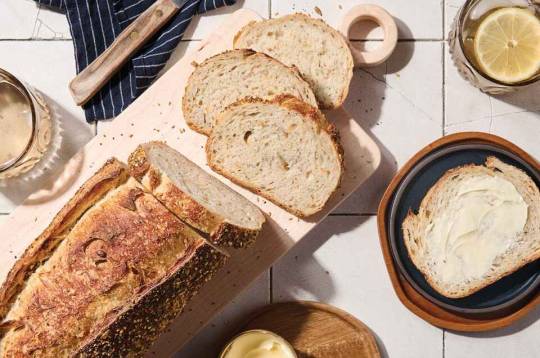
Making of Sourdough
Sourdough’s simplicity is one of its key attractions. Traditionally, it’s made from just three ingredients: flour, water, and salt. This simplicity is a stark contrast to many commercially produced breads that contain a plethora of additives. The slow fermentation process of sourdough, where natural yeasts and bacteria interact with the dough, is what sets it apart. This process not only imparts a distinct tangy flavor but also influences the bread’s health properties.
Odd Water Secret Melts Stubborn Fat
Sourdough Health Benefits
Sourdough’s health benefits are closely tied to its fermentation process. Priya Tew, an award-winning dietitian, explains, “Genuine sourdough bread can be more easily digested and can be lower in glycemic index than some shop-bought bread.” This lower glycemic index means sourdough doesn’t spike blood sugar levels as sharply as other breads, which is a crucial factor in weight management.
Gut Health: The fermentation process increases prebiotic and probiotic-like properties, which can improve gut health. Sourdough made with whole grains offers additional fiber, enhancing these gut-friendly benefits.
Digestion: Sourdough might improve the digestion of gluten due to changes in wheat enzymes during fermentation. While not suitable for people with celiac disease, those sensitive to gluten might find sourdough easier to digest.
Healthy Aging: Sourdough, a staple in the Mediterranean diet, is linked to healthy aging. It has antioxidant, anti-hypertensive, anti-diabetic, and FODMAP-reducing qualities.
Shrink X™ Powerful Pet Probiotic Formula
Sourdough Fermentation Benefits:
The fermentation process in sourdough bread leads to an increase in prebiotic and probiotic-like properties, which are beneficial for gut health. A 2021 review in the journal Microorganisms highlights this, noting that these properties help improve gut health. Additionally, the fermentation process enhances the bioavailability of nutrients like calcium, phosphorus, and iron, making them more accessible to the body.
Nutritional Profile:
A slice of sourdough bread typically contains about 84 calories, 16 grams of carbohydrates, 1 gram of fiber, 3 grams of protein, and 1 gram of total fat. Laura Tilt, a registered dietitian, points out, “White sourdough is a source of carbohydrates, calcium, iron, vitamin B1, and B3, forming part of a healthy diet.” However, she advises opting for wholewheat varieties for higher fiber content.
Facts about Sourdough Bread
Historical Popularity Surge: Sourdough’s recent popularity isn’t just a modern trend. Its global market value skyrocketed from $298.7 million to a staggering $2.4 billion in 2018. This surge reflects a growing awareness and appreciation of sourdough’s unique qualities and health benefits.
Enhanced Taste with Health Benefits: The fermentation process in sourdough not only contributes to its health benefits but also enhances its taste. Priya Tew notes that fermentation produces amino acids that add extra flavor, despite a decreased salt content in the bread. This means you get a tasty bread that’s also good for you.
B12 Enrichment: The fermentation of plant-based foods like sourdough can lead to the enrichment of vitamin B12. This is particularly noteworthy since B12 is typically associated with animal-based foods, making sourdough a valuable addition to vegetarian diets.
Impact on Blood Sugar Levels: Sourdough bread’s fermentation process results in a lower glycemic index compared to regular bread. This means it has a less dramatic impact on blood sugar levels, making it a smarter choice for those managing diabetes or looking to maintain stable energy levels throughout the day.
Variety in Sourdough Types: The diversity of sourdough bread is vast. From traditional white sourdough to wholewheat and rye varieties, each type offers different nutritional benefits. For instance, rye sourdough is known for its higher fiber content, while traditional white sourdough is fortified with essential vitamins and minerals.
Expert Opinion of Sourdough Bread on Weight Loss:
Experts agree that sourdough can be part of a weight loss diet. Tilt reminds us, “All foods can be part of a weight loss diet; it’s about balance and portion size.” She suggests pairing sourdough with nutrient-dense foods like eggs or nut butter for a balanced meal. The high fiber content in sourdough, especially in wholegrain varieties, is linked to feeling full for longer, which is beneficial for weight management.
Promote Deep Sleep and Relaxation
FAQs around Is Sourdough Bread Good for Weight Loss?
Can sourdough bread help in weight loss?
Yes, sourdough bread can be part of a weight-loss diet. Its high fiber content, especially in wholegrain varieties, helps you feel full longer, which can aid in managing calorie intake.
Is sourdough bread lower in calories than regular bread?
Sourdough bread’s calorie content is comparable to many other types of bread. However, its nutritional composition, particularly its lower glycemic index, makes it a healthier choice that can fit into a weight loss diet.
Does sourdough bread cause blood sugar spikes?
Sourdough bread has a lower glycemic index compared to many other breads, meaning it causes a slower and less dramatic rise in blood sugar levels. This makes it a suitable option for those managing blood sugar levels.
Can I eat sourdough bread every day if I’m trying to lose weight?
Yes, you can include sourdough bread in your daily diet while trying to lose weight. Remember, balance and portion control are key. Pairing it with nutrient-dense foods can make your meals more satisfying and nutritionally balanced.
Is sourdough bread better than whole wheat bread for weight loss?
Sourdough and whole wheat breads each have their benefits. Sourdough’s fermentation process can make it easier to digest and lower in glycemic index, while whole wheat bread is typically higher in fiber. Your choice may depend on personal dietary needs and preferences.
Does the type of flour used in sourdough affect weight loss?
Yes, the type of flour affects the nutritional content of sourdough bread. Wholegrain flours are higher in fiber and nutrients compared to refined flours, making them a better choice for weight loss.
Is sourdough bread gluten-free?
No, traditional sourdough bread is not gluten-free as it is made from wheat flour. However, the fermentation process can break down some of the gluten, making it easier to digest for those with mild gluten sensitivities, but it is not suitable for individuals with celiac disease.
Life Extension GEROPROTECT Stem Cell
Sourdough bread, with its unique fermentation process and nutritional profile, offers several health benefits that can support weight loss goals. Its lower glycemic index, coupled with a higher fiber content, especially in wholegrain varieties, makes it a healthier choice compared to many other breads. While sourdough alone isn’t a magic bullet for weight loss, it can be a valuable part of a balanced and nutrient-rich diet. Variety and moderation are key to a healthy diet and effective weight management.
2 notes
·
View notes
Text
Natural Hair Care – A Comprehensive Guide
Natural haircare routines are essential to keeping locks looking their best and healthy. Finding a style that works for you and sticking to it are the keys to successful locks care.
Afro-textured hair presents unique challenges when it comes to styling and maintenance. Many women turn to natural hair regimens to address these concerns.
Understanding Your Hair Type
Before embarking on your natural hair journey, you must understand what type of texture your hair possesses. Doing this will enable you to choose an appropriate style and care for it appropriately.
Although many people use various products on their hair, reducing this use will help promote healthier growth. Selecting natural options tailored to your hair texture will simplify styling.
If your straight hair tends to get oily quickly, using dry shampoo might help control the excess production of oils. Or you could try applying a light serum that distributes oils evenly across your scalp.
If you have wavy or curly locks, lightweight mousse or curl-defining cream is an excellent way to style them. Remember not to add too much product, as too much can weigh down and lead to frizz. To keep strands looking smooth and manageable, avoid combing too often and opt for protective styles like braids or weaves; styling gel can also add definition.
The Importance of a Balanced Diet for Hair Health
Beginning the journey to healthier hair starts with eating well. According to trichologist Guy Parsons, healthy hair can be defined as “hair that grows from each follicle in an orderly fashion and aligns well with an intact scalp.”
He suggests including high-protein foods into your diet, such as sardines (which have low saturated fat content), mackerel, and salmon, as they contain omega-3 fatty acids, protein, and vitamin B2 B3 D which all play an integral part in keeping hair strands healthy.
Avoid over-washing, as this can strip natural oils from your hair, leaving strands looking dry. Parsons recommends a natural shampoo free from sulfates and alcohol for best results.
Natural hair care ingredients, like aloe vera, tea tree oil, and apple cider vinegar, can help balance your scalp’s pH level, reduce inflammation, and kill any dandruff-causing fungus that might otherwise exist on your strands. They may even add shine. Lastly, drink plenty of water throughout the day to hydrate strands properly and prevent breakage or split ends; adding leave-in conditioner or hydrating spray into your routine can further assist this goal.
Natural Ingredients for Hair Care
As you establish a hair care routine, search for natural ingredients that nourish and protect your strands. Renewable botanical oils like shea butter, jojoba oil, and argan oil help keep your scalp’s natural oils intact while shielding the ends of strands from damage. Utilizing such natural remedies reduces your need for harsh chemicals that could otherwise dry out and flake out your locks, causing itchy follicles or flaky scalps.
Avoid products containing sulfates as these substances have been known to irritate skin and cause genetic mutation. If possible, seek natural products labeled “sulfate-free.”
Tea tree oil is another fantastic ingredient to look out for when selecting shampoo and conditioner products, as it stimulates hair follicles to promote growth while profoundly nourishing hair and scalp. Aloe vera also plays an integral role in maintaining healthy scalp conditions. At the same time, its low molecular weight allows it to penetrate hair strands to leave soft, smooth locks with healthy-looking locks.
DIY Natural Hair Masks
There are a few natural hair products you can incorporate into your routine to protect it from damage, such as:
NaturAll’s deep conditioning treatment for dry, thirsty tresses is perfect for parched locks. It contains raw avocado – known for its hydrating properties – and organic tea tree oil to prevent infections and deep conditioning agents that will keep your locks hydrated all day.
BeautyKLove’s shampoo scrub may provide an easy remedy for oily scalp. This DIY recipe features baking soda to remove build-up. At the same time, apple cider vinegar closes the cuticle and prevents frizz by closing hair cuticles – leaving your locks smoother and less susceptible to frizz than before!
This natural hair mask is an excellent solution for anyone with damaged locks, thanks to the combination of avocado (known for its nourishing properties), coconut oil, and essential oils such as thyme for stimulating growth, rosemary for decreasing protein loss, and lavender to soothe your scalp. Furthermore, Boucleme contributes back to its local community by sourcing its ingredients from there.
How to Protect Your Hair from Damage
Establishing an effective natural hair routine is critical to keeping your locks healthy. Regular deep conditioning treatments help hydrate dry, brittle strands and replenish their essential natural oils that may have been stripped from them during shampooing.
Ensure not to overwash your strands, which may lead to product buildup. Instead, wash once or twice weekly using lukewarm water for best results.
Limit heat exposure, as overexposure can lead to brittleness in your hair using protective styles like braids, bantu knots, puffs, or wash-and-go styles.
No matter the situation, natural products offer solutions. From shampoo that helps combat dandruff to conditioner that will bring moisture back into your strands and even hair masks that repair damage – there is something suitable for everyone in your search for natural beauty solutions! By sticking to your routine, you can achieve your best look ever while maintaining health – good luck and congratulations on achieving an authentic natural style!
Tips for Natural Hair Styling
Two-strand twists are one of the most sought-after natural hairstyles, as they’re straightforward and leave your locks looking lush and healthy.
There are numerous approaches to accomplish this look, but here are a few suggestions:
Tip 1: Do not overwash your hair; this can strip it of its natural oils and lead to product build-up. Instead, try washing with lukewarm water once weekly for best results.
When washing your hair, always opt for a high-quality shampoo free from sulfates, mineral oil, and parabens as these ingredients can harm the scalp and hair follicles. A natural hair shampoo will hydrate and protect locks while clearing away dirt or oils that build up from daily activities – this will also help to ensure healthier locks! To further ensure healthy locks, it is also essential to utilize deep conditioner after each wash session while limiting heat exposure, as these will all help foster good hair habits.
Maintaining Hair Health: Do’s and Don’ts
As someone new to natural haircare, it may take time to master proper care of your strands. From overwashing to overusing products, common errors could harm the condition of your natural curls.
As always, we’re here to help you avoid these errors and foster vibrant, beautiful locks with healthy locks that look vibrant. From switching up shampoos and scheduling regular haircuts, here are a few tips for maintaining natural beauty.
Be sure to use a wide-tooth comb when detangling, and keep strands hydrated with oil, spritzes, and DIY packs. Furthermore, try to stick to a routine of trimming ends at least every eight weeks, keeping strands strong and preventing split ends from becoming knotted up. Furthermore, avoid products containing sulfates and phosphates, which can strip your scalp of its natural oils and lead to dry, itchy locks; instead, opt for organic products with natural ingredients.
Case Study: Success Stories with Natural Hair Care
While plenty of advice may be available on natural haircare, not all approaches work equally. What may work for one person may not necessarily work for you; therefore, it is crucial that you experiment and find what best fits you and your specific routine.
Blogger Afrobella Yursik has found great success with her natural hair journey. She quickly garnered an extensive readership on her blog, becoming a full-time influencer working with brands to promote natural products.
Shanique Buntyn has become one of YouTube’s most successful natural hair entrepreneurs since 2007. Known for her comprehensive tutorial videos spanning makeup to transitioning natural hair, Buntyn provides valuable resources for women looking to transition or newcomers just starting in their natural hair journey. Her tutorials offer guidance through basic steps while helping create routines tailored specifically to you; her advice: Keep things simple as no one knows your locks like you!
Read more here https://selectproducts.shopping/natural-hair-care-a-comprehensive-guide/
2 notes
·
View notes
Text
Lentils in Hindi & English
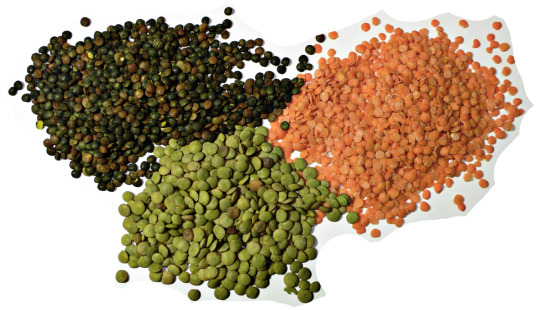
Lentils are a type of legume that are commonly used as a food source. They are small, round, and typically come in a variety of colors such as brown, green, yellow, and red. Lentils are a rich source of protein, fiber, and various minerals and vitamins, making them a popular ingredient in many dishes around the world.
One of the most notable benefits of lentils is their high protein content. They are an excellent source of plant-based protein, making them a great alternative for vegetarians and vegans. They are also a good source of essential amino acids, which are important for maintaining muscle mass, repairing tissues, and supporting overall health.
In addition to protein, lentils are also a great source of dietary fiber. They are high in both soluble and insoluble fibers, which helps to promote healthy digestion and regular bowel movements. Soluble fiber can also help to lower cholesterol levels and regulate blood sugar levels.
Lentils are also a good source of various minerals and vitamins. They are particularly high in iron, folate, and manganese. Iron is important for the production of hemoglobin, which carries oxygen to the body's tissues, while folate is important for the production of red blood cells. Manganese is important for maintaining healthy bone structure and wound healing. They are also a good source of vitamin B1, B3, B5 and minerals like potassium, phosphorus and zinc.
Lentils can be used in many different dishes, such as soups, stews, curries, and salads. They can also be ground into flour and used to make bread, pasta, and other baked goods. They are a versatile ingredient that can be used in a variety of ways, making them a great addition to any meal.
One of the most popular dishes that use lentils is dal (lentils in hindi), which is a staple in Indian cuisine. Dal is a lentil-based dish that is often cooked with spices and served with rice or bread. It can be made with different types of lentils, such as moong, masoor, chana, and toor dal, each with its unique flavor and texture.
Lentils are also a popular ingredient in Mediterranean and Middle Eastern cuisine. In Egypt, lentils are used to make koshari, a dish made with lentils, pasta, and rice. In Syria, lentils are used to make mjadara, a dish made with lentils, rice, and caramelized onions. In Lebanon, lentils are used to make foul medames, a dish made with lentils, fava beans, and spices.
Overall, lentils are a nutritious and delicious food that can be enjoyed in many different ways. They are a great source of protein, fiber, and various minerals and vitamins, making them a healthy addition to any diet. Whether you're looking to add more plant-based protein to your diet or simply looking for a tasty and versatile ingredient to use in your cooking, lentils are a great choice.
6 notes
·
View notes
Text
Vitamin B3, niacin (from tobacco)
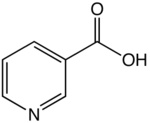
Nicotinic acid (Na) is one of the three structural isomers of pyridinecarboxylic acid. Nicotinic acid and nicotinamide are collectively called niacin. Niacin corresponds to vitamin B3 in the vitamin B group.
history
In 1867, it was discovered as a carboxylic acid obtained by oxidizing the alkaloid nicotine, and was given the common name nicotinic acid. In 1911, Umetaro Suzuki and C. Funk isolated it from living organisms as a pellagra-preventive factor. In 1937 C.A.Elvehjem revealed that nicotinic acid is a vitamin. Around the end of the 20th century, annual global production of nicotinic acid reached more than 10,000 tons[2]. However, most of it was produced for feed, and nicotinic acid for human food additives and pharmaceuticals was less than 10% of the total production.
Manufacturing method/Biosynthesis
It is obtained by oxidizing pyridine derivatives such as β-picoline with a side chain at the 3-position with strong oxidizing agents such as nitric acid and potassium permanganate. It is also synthesized by a method of constructing a pyridine ring. Salts of nicotinic acid and copper are sparingly soluble in water.
In animals and fungi, it is synthesized in vivo from tryptophan via kynurenine and 3-hydroxyanthranilic acid, while in plants and bacteria it is biosynthesized from aspartic acid and the C3 unit, a glycerol-related metabolite.
physiological activity
Main article: Niacin
In vivo, nicotinamide adenine dinucleotide and nicotinamide adenine dinucleotide phosphate containing nicotinic acid in a partial structure are hydrogen acceptors of oxidoreductases and are important as coenzymes.
ニコチン酸(ニコチンさん、英: nicotinic acid、Na)とは、ピリジンカルボン酸(英語版)の3つの構造異性体の中の1つである。ニコチン酸とニコチン酸アミドを総称してナイアシンと呼ばれる。ナイアシンは、ビタミンB群の中のビタミンB3に当たる。
歴史
1867年にアルカロイドのニコチンを酸化して得られるカルボン酸として発見され、ニコチン酸という慣用名が与えられた。1911年に鈴木梅太郎およびC.Funkらが生体より抗ペラグラ因子(こうペラグラいんし、pellagra‐preventive factor)として単離した。ニコチン酸がビタミンであることは、1937年にC.A.Elvehjemによって明らかにされた。 20世紀末頃で世界中の1年間のニコチン酸の生産量を合算すると、1万トン以上に達していた[2]。ただし、その大部分は飼料用として生産されていた物であって、ヒトに用いる食品添加物や医薬品用のニコチン酸は、全生産量の1割にも満たない量であった。
製法・生合成
3位に側鎖を持つβ-ピコリンなどピリジン誘導体を、硝酸や過マンガン酸カリウムなど強い酸化剤で酸化すると得られる。また、ピリジン環を構築する方法でも合成される。ニコチン酸と銅との塩は、水に溶けにくい。
動物・菌類では生体内で、トリプトファンからキ��レニン、3‐ヒドロキシアントラニル酸を経由して、一方、植物や細菌ではアスパラギン酸とグリセロール近縁代謝物質であるC3ユニットから生合成される。
生理活性
詳細は「ナイアシン」を参照
生体内では、ニコチン酸を部分構造に含むニコチンアミドアデニンジヌクレオチドやニコチンアミドアデニンジヌクレオチドリン酸が、酸化還元酵素の水素受容体であり、補酵素として重要である。
Wikipediaより
Smoke (tobacco) is an indispensable material for human beings.
Rei Morishita
#Vitamin B3#Niacin#tobacco#nicotinic acid#coenzymes#Wikipedia#Rei Morishita#Smoke (tobacco) is an indispensable material for human beings.#smoke
3 notes
·
View notes